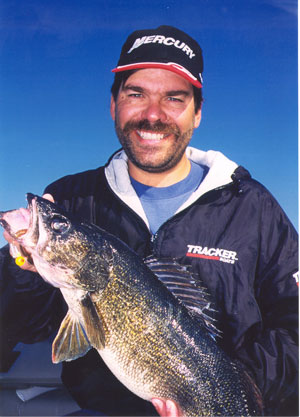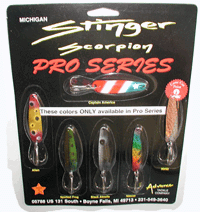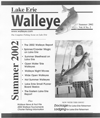Playing the "Waiting Game" … that’s what it feels like we’ve been doing
all winter … waiting for the ice to be gone and the walleye bite to begin.
Well now the winter season is done and it’s time to
 begin
looking for open water in the pursuit of fast walleye action. But as we
enter another fishing season, there’s another game we need to be prepared
for if we’re going to consistently score walleyes … the "Weighting Game". So
many of the tactics employed in walleye fishing require the use of some sort
of weighting system … jigs, split-shot, slip sinkers, bottom bouncers, Snap
Weights, in-line weights, and lead core line all have a place and time that
they’re most productive. The key is to know what system will work best in
any given situation. We could write a book covering all the aspects of
weighting systems, but here’s an overview of the basics for choosing
weighting systems by application.
begin
looking for open water in the pursuit of fast walleye action. But as we
enter another fishing season, there’s another game we need to be prepared
for if we’re going to consistently score walleyes … the "Weighting Game". So
many of the tactics employed in walleye fishing require the use of some sort
of weighting system … jigs, split-shot, slip sinkers, bottom bouncers, Snap
Weights, in-line weights, and lead core line all have a place and time that
they’re most productive. The key is to know what system will work best in
any given situation. We could write a book covering all the aspects of
weighting systems, but here’s an overview of the basics for choosing
weighting systems by application.
Many anglers wouldn’t think of jigs as a weighting system, but in reality
a jig is simply a lead weight connected directly to a hook … about as basic
a weighting system as you’re likely to get. While jigs come in a wide array
of styles and designs, for the most part they all do the same thing … carry
the bait down to where the fish are. The key to being successful with jigs
is using them in the right situations. Jigs are best when the bait needs to
be presented with precision, on or near the bottom. This can be done by
vertical jigging, or by pitching small jigs to shallow structure. In most
cases you want to use the lightest weight jig possible to maintain bottom
contact.
Besides the bait used to tip the jig hook, other factors that attract
walleyes to jigs include the jig’s color and the action the angler imparts
to the jig. One of the newest trends in jig color is holographic finishes
like those found on the Bass Pro line of XPS Walleye Jigs. These types of
finishes combine both color and flash for real "eye-catching" appeal. When
you need to put the bait right on a fish’s nose, few presentations work
better than a jig.
Walleyes are notorious for being finicky at times, and when that’s the
scenario you’re facing, a slip-sinker live bait rig is tough to beat.
Situations like when fish are relating fairly tight to structure such as
points, humps or a channel edge, and seem to want live bait presented slow
and with finesse are ideal for the slip-sinker rig. The bait, be it a
minnow, leech or crawler, is allowed to swim freely on a light hook and
leader with the sinker, separated from the leader by a swivel, keeping the
presentation down in the strike zone. When a walleye takes the bait, the
angler can free spool line allowing the fish to move off and get the hook
well into its mouth before the line is tightened and a sweeping hookset
drives the point home.
One variable in live bait rigging is the length of leader used. Standard
leader length is usually around 24 inches, but if you’re fishing very clear
water and moving very slowly to tempt biters concentrated in a small area,
it’s not unusual to use a leader of 4 to six feet or even more. A
slip-sinker rig like Northland Tackle’s Roach Rig is designed with a
moveable "sinker stop" which allows the angler to adjust leader length
quickly and easily without retying the entire rig. Fine tune your
slip-sinker rig to get just the right weight sinker and leader length and
there are few presentations deadlier on finicky walleyes.
Another form of live bait rig that fits into the category of
"ultra-finesse" would be the split-shot rig. This is fishing at its most
basic … a hook, line and sinker. It’s a great rig to use for fishing bait in
sparse shallow weeds, or over rocky bottoms where a heavier sinker would
snag up instantly. Pinch the shot onto the line 12 to 18 inches up from the
hook, choosing a split-shot just heavy enough to get the bait barely ticking
the bottom. The split-shot rig can be cast and slowly worked back to the
boat, or it’s deadly on a slow drift.
Up to now the weighting systems we’ve covered are primarily for slow,
methodical presentations. But there are times when covering water will not
only put your bait in front of more fish, but trip the trigger of many that
may ignore a slower moving presentation. No doubt, one of the most versatile
and productive weighting systems any walleye angler can stock in his arsenal
are bottom bouncers. Bouncers are basically an inverted "L" shaped piece of
wire with a lead weight molded on the longer of the two arms.
Typical bouncer weights run from 1 to 2 ounces, but they are made in a
wide range of weights from 1/4 ounce models for finesse bouncer
presentations to 4 or 5 ounce models for fishing quickly in deep water. The
design of the bottom bouncer helps make them relatively snag resistant, one
reason they have grown in popularity especially for anglers fishing large
reservoirs and rivers where rocks and timber tend to eat lesser
presentations. Bouncers can be run with a plain snell and live bait for
ultra-slow trolling in deep water or drifting mid-depth flats. However, the
more popular presentation is to dress the bouncer with an in-line spinner
tipped with a nightcrawler and trolled over structure at speeds in the ¾ to
1.5 mph range. Match your bouncer weight to the depth and speed you’re
fishing so that the bouncer runs at about a 45 degree angle from the rod tip
and the bottom arm of the bouncer is just ticking bottom. Then it’s merely a
matter of covering water until a fish grabs hold.
One adaptation of the bouncer that is really catching on in walleye
circles is the use of sliding bottom bouncers. Marrying the best traits of
the time-tested slip-sinker with the versatility and effectiveness of the
bottom bouncer, slip bouncers like Northland Tackle’s Rock-Runner Slip
Bouncer are proving to be "The" live bait weighting system on walleye waters
everywhere. The beauty of such a system is the ability for the angler to
fish a piece of structure with a finesse presentation, but do so quicker and
more snag-free than would be possible with a conventional slip-sinker rig.
Once fish are contacted, the angler can instantly switch gears and fish much
like he would with a slip-sinker rig, hovering over the fish, feeding line
once a fish hits before sweeping the hook home. Once you get the hang of
fishing bottom bouncers, fixed or sliding, you’ll quickly learn why they are
walleye fishing’s most versatile weighting system.
Many trolling presentations used for walleyes utilize various weighting
systems too. In Part 2 of this series, we’ll cover the different methods of
adding weight to your trolling set-ups to help you dial in your baits to the
perfect depth and get you hooked up with more walleyes.





 begin
looking for open water in the pursuit of fast walleye action. But as we
enter another fishing season, there’s another game we need to be prepared
for if we’re going to consistently score walleyes … the "Weighting Game". So
many of the tactics employed in walleye fishing require the use of some sort
of weighting system … jigs, split-shot, slip sinkers, bottom bouncers, Snap
Weights, in-line weights, and lead core line all have a place and time that
they’re most productive. The key is to know what system will work best in
any given situation. We could write a book covering all the aspects of
weighting systems, but here’s an overview of the basics for choosing
weighting systems by application.
begin
looking for open water in the pursuit of fast walleye action. But as we
enter another fishing season, there’s another game we need to be prepared
for if we’re going to consistently score walleyes … the "Weighting Game". So
many of the tactics employed in walleye fishing require the use of some sort
of weighting system … jigs, split-shot, slip sinkers, bottom bouncers, Snap
Weights, in-line weights, and lead core line all have a place and time that
they’re most productive. The key is to know what system will work best in
any given situation. We could write a book covering all the aspects of
weighting systems, but here’s an overview of the basics for choosing
weighting systems by application.